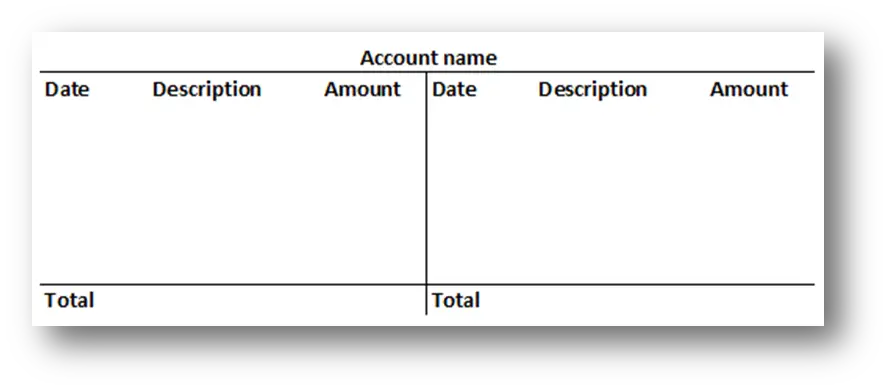The accounting process involves various stages. The starting point within this process is a transaction. Once a company participates in this transaction, it must record it in the books of prime entry. Consequently, it reaches the general ledger, which helps prepare the trial balance and financial statements. The general ledger is the base for all accounting systems. Sometimes, companies represent general ledgers as T-accounts.
What is a T-Account?
A T-account is a presentation of the general ledger. As the name suggests, this presentation resembles the shape of the alphabet “T”. A T-account includes two sides, a debit, and a credit. The left side is the debit, while the credit entries go on the right. The term T-account may also refer to the general ledger for a specific account within the financial system.
The T-account presentation for the general ledger is often informal. Most companies use accounting software to create their records. Usually, this software prepares the account ledger in a traditional format. However, the T-account presentation is clearer and more concise. On top of that, it focuses on simplifying the general ledger with a visual impact.
What is the format of the T-Account?
As stated above, the T-account format resembles the alphabet “T”. The line in the middle separates the debit and credit sides. For each side, the T-account includes at least three columns. These columns contain the date, description, and amount of the transaction reported. The top line holds the name of the account for which the company prepares the T-account.

T account format example
At the bottom of the T-account, companies total the debit and the credit side. However, if one side exceeds the other, they must create a balance for the lower side. This balance will equal the difference between those sides. Once companies record the balancing figure, the total for both sides will match. This balancing figure will become the balance for the account in the trial balance.
Some formats may omit the date column for both sides and aggregate transactions. However, the description and amount columns will remain. Usually, the description column includes the account name for the other side of the double entry. The amount column will only consist of the value for which this account is debited or credited.
What is the difference between the T-account and General Ledger?
Some people think the T-account and general ledger are different. However, the T-account is a visual representation of the latter. Both terms do not differ from each other. Sometimes, these terms may refer to the varying visual presentations used to present an account. Companies use T-accounts to represent general ledger accounts differently.
In a traditional general ledger format, companies record transactions consecutively. This format includes the date, description, debit, and credit columns. However, it does not separate debits and credits on different sides. On top of that, companies record transactions as they occur in this format. However, the T-account segregates transactions into credit and debit sides.
Conclusion
General ledgers are the base for preparing the trial balance and financial statements. Companies record transactions into different accounts in these records. Sometimes, they may use the T-account format to present these accounts. This format is straightforward and includes two sides, debit, and credit. Each side usually contains three columns, date, description, and amount.
Further questions
What's your question? Ask it in the discussion forum
Have an answer to the questions below? Post it here or in the forum




